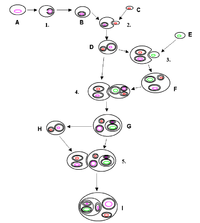
Photo from wikipedia
Abstract Heritable bacterial endosymbionts can alter the biology of numerous arthropods. They can influence the reproductive outcome of infected hosts, thus affecting the ecology and evolution of various arthropod species.… Click to show full abstract
Abstract Heritable bacterial endosymbionts can alter the biology of numerous arthropods. They can influence the reproductive outcome of infected hosts, thus affecting the ecology and evolution of various arthropod species. The spruce bark beetle Pityogenes chalcographus (L.) (Coleoptera: Curculionidae: Scolytinae) was reported to express partial, unidirectional crossing incompatibilities among certain European populations. Knowledge on the background of these findings is lacking; however, bacterial endosymbionts have been assumed to manipulate the reproduction of this beetle. Previous work reported low-density and low-frequency Wolbachia infections of P. chalcographus but found it unlikely that this infection results in reproductive alterations. The aim of this study was to test the hypothesis of an endosymbiont-driven incompatibility, other than Wolbachia, reflected by an infection pattern on a wide geographic scale. We performed a polymerase chain reaction (PCR) screening of 226 individuals from 18 European populations for the presence of the endosymbionts Cardinium, Rickettsia, and Spiroplasma, and additionally screened these individuals for Wolbachia. Positive PCR products were sequenced to characterize these bacteria. Our study shows a low prevalence of these four endosymbionts in P. chalcographus. We detected a yet undescribed Spiroplasma strain in a single individual from Greece. This is the first time that this endosymbiont has been found in a bark beetle. Further, Wolbachia was detected in three beetles from two Scandinavian populations and two new Wolbachia strains were described. None of the individuals analyzed were infected with Cardinium and Rickettsia. The low prevalence of bacteria found here does not support the hypothesis of an endosymbiont-driven reproductive incompatibility in P. chalcographus.
Journal Title: Journal of Insect Science
Year Published: 2018
Link to full text (if available)
Share on Social Media: Sign Up to like & get
recommendations!